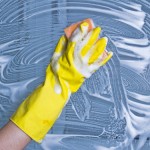
A new list by Environmental Working Group (EWG) and the Keep A Breast Foundation identifies some of the most problematic hormone-altering, endocrine disrupting, chemicals to which people are routinely exposed.
Hormone-disrupting chemicals are external substances that alter the functions of the endocrine system (the system of glands that produce secretions that help to control bodily activity). Hormone disruptors include a variety of industrial chemicals that are used in cleaning products and pesticides.
“We are all routinely exposed to endocrine disruptors, and this has the potential to significantly harm the health of our youth,” said Renee Sharp, EWG’s director of research. “It’s important to do what we can to avoid them, but at the same time we can’t shop our way out of the problem. We need real chemical policy reform.”
EWG researchers compiled the new Dirty Dozen list by scouring the scientific literature and identifying the most hazardous and widely used hormone-disrupting chemicals that pollute the environment and, ultimately, our bodies. These substances are frequently found in food, water and consumer products, and studies have linked them to a wide array of health problems, including cancer, birth defects, lowered sperm count, lowered IQ and thyroid disease.

Here’s the list detailing how to avoid contact with these chemicals:
BPA—Eat fresh foods instead of canned, as many food cans are lined with BPA, or research which companies don’t use BPA or similar chemicals in their products. Say no to receipts, since thermal paper is often coated with BPA. And avoid plastics marked with a PC, for polycarbonate, or recycling label #7. Not all of these plastics contain BPA, but many do.
Dioxin—This is difficult, since the ongoing industrial release of dioxin has meant the U.S. food supply is widely contaminated. Products such as meat, fish, milk, eggs and butter are most likely to be contaminated, but you can cut down your exposure by eating fewer animal products.
Atrazine—Buy organic produce and get a drinking water filter certified to remove atrazine.
Phthalates—Avoid plastic food containers, children’s toys (some phthalates are already banned in kid’s products), and plastic wrap made from PVC, which has the recycling label #3. Some personal care products also contain phthalates, so read the labels and avoid products that simply list added fragrance, since this catch-all term sometimes means phthalates.
Perchlorate—Install a reverse osmosis filter. It’s nearly impossible to avoid perchlorate in food, but you can reduce its potential effects by making sure you are eating enough iodine. Eating iodized salt is one simple way.
Fire retardants—Use a vacuum cleaner with a HEPA filter, which can cut down on toxic-laden house dust; avoid reupholstering foam furniture; take care when replacing old carpet (the padding underneath may contain PBDEs). Fire retardants are in many products. Passing better toxic chemical laws that require chemicals to be tested before they go on the market would help reduce our exposure.
Lead—Keep your home clean and well maintained. Crumbling old paint is a major source of lead exposure, so get rid of it carefully. A good water filter can also reduce your exposure to lead in drinking water. Studies also have shown that children who eat healthy diets absorb less lead.
Arsenic—Use a water filter that lowers arsenic levels.
Mercury—If you still want to eat (sustainable) seafood with healthy fats, wild salmon and farmed trout are good choices. Choose mercury-free cosmetics.
Perfluorinated chemicals (PFCs)—Skip non-stick pans as well as stain- and water-resistant coatings on clothing, furniture and carpets.
Organophosphate pesticides—Buy organic produce.
Glycol Ethers—Avoid paints, cleaning products, brake fluid and cosmetics products with ingredients such as 2-butoxyethanol (EGBE) and methoxydiglycol (DEGME).
[source: http://ecowatch.com/2013/10/28/12-ways-avoid-hormone-disrupting-chemicals-everyday-products/]

Leave a Reply
You must be logged in to post a comment.